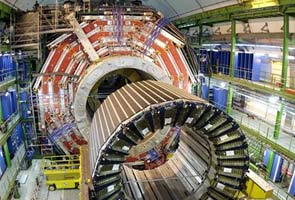- Home
- Others
- Others News
- Top 8 facts about CERN Large Hadron Collider
Top 8 facts about CERN Large Hadron Collider

1. The LHC comprises four huge labs interspersed around a ring-shaped tunnel near Geneva, 27 kilometres (16.9 miles) long and up to 175 metres (568 feet) below ground.
2. Beams of hydrogen protons are accelerated in opposite directions to more than 99.9999 percent of the speed of light. Powerful superconducting magnets, chilled to a temperature colder than deep space, then "bend" the beams so that streams of particles collide within four large chambers.
3. The smashups fleetingly generate temperatures 100,000 hotter than the Sun, replicating the conditions that prevailed just after the "Big Bang" that created the Universe 13.7 billion years ago.
4. Swathing the chambers are detectors that give a 3-D image of the traces of sub-atomic particles hurled out from the protons' destruction. These traces are then closely analysed in the search for movements, properties or novel particles that could advance our understanding of matter.
5. In top gear, the LHC is designed to generate nearly a billion collisions per second. Above ground, a farm of 3,000 computers, one of the largest in the world, instantly crunches the number down to about 100 collisions that are of the most interest.
6. Peak LHC collisions generate 14 teraelectron volts (TeV), amounting to a high concentration of energy but only at an extraordinarily tiny scale. One TeV is the equivalent energy of motion of a flying mosquito. There is no safety risk, says CERN (the European Organisation for Nuclear Research).
7. Other LHC investigations include supersymmetry -- the idea that more massive particles exist beyond those in the Standard Model -- and the mystery why anti-matter is so rare compared to matter, its counterpart. Supersymmetry could explain why visible matter only accounts for some four percent of the cosmos. Dark matter (23 percent) and dark energy (73 percent) account for the rest.
8. Completed in 2008, the LHC cost 6.03 billion Swiss francs (five billion euros, $6.27 billion, at today's rates of conversion).
For the latest tech news and reviews, follow Gadgets 360 on X, Facebook, WhatsApp, Threads and Google News. For the latest videos on gadgets and tech, subscribe to our YouTube channel. If you want to know everything about top influencers, follow our in-house Who'sThat360 on Instagram and YouTube.
Related Stories
- Galaxy S24 Series
- MWC 2024
- Apple Vision Pro
- Oneplus 12
- iPhone 14
- Apple iPhone 15
- OnePlus Nord CE 3 Lite 5G
- iPhone 13
- Xiaomi 14 Pro
- Oppo Find N3
- Tecno Spark Go (2023)
- Realme V30
- Best Phones Under 25000
- Samsung Galaxy S24 Series
- Cryptocurrency
- iQoo 12
- Samsung Galaxy S24 Ultra
- Giottus
- Samsung Galaxy Z Flip 5
- Apple 'Scary Fast'
- Housefull 5
- GoPro Hero 12 Black Review
- Invincible Season 2
- JioGlass
- HD Ready TV
- Laptop Under 50000
- Smartwatch Under 10000
- Latest Mobile Phones
- Compare Phones
- Motorola Edge 50 Fusion
- Oppo A1i
- Oppo A1s
- Motorola Edge 50 Ultra
- Leica Leitz Phone 3
- Moto G64 5G
- Moto G04s
- iQOO Z9 Turbo
- Asus ZenBook Duo 2024 (UX8406)
- Dell Inspiron 14 Plus
- Realme Pad 2 Wi-Fi
- Redmi Pad Pro
- Cult Shock X
- Fire-Boltt Oracle
- Samsung Samsung Neo QLED 8K Smart TV QN800D
- Samsung Neo QLED 4K Smart TV (QN90D)
- Sony PlayStation 5 Slim Digital Edition
- Sony PlayStation 5 Slim
- Onida 1.5 Ton 3 Star Inverter Split AC (IR183TSN)
- Haier 1.5 Ton 3 Star Window AC (HWU18TF-EW3BE-FS)

















